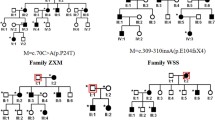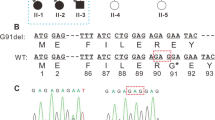Abstract
Background
An isolated form of congenital cataract associated with macular hypoplasia and a generally hypopigmented fundus in infancy was observed in a German family. To test the hypothesis that a de-novo mutation had occurred in one of the parental germ lines, a functional candidate gene approach was applied.
Methods
The family was carefully examined by a senior paediatric ophthalmologist according to routine procedures (slit lamp, funduscopy, ERG). Blood was taken from the proband and his parents, genomic DNA was isolated and some candidate genes for cataract (CRYAA, CRYBB2, GJA8) or macular hypoplasia (OA1, P) or both (PAX6) were analyzed.
Results
The proband showed bilateral cataracts at the age of 4 months; the fundus appeared pale, the optic disc grayish, and macular reflexes were absent. After cataract surgery, the nystagmus persisted, and a control ERG at age 9 years showed essentially normal scotopic and photopic wave forms. An infectious aetiology as well as galactosemia were excluded. However, a heterozygous mutation was found in the proband in exon 1 of CRYAA (62 C→T), which leads to an exchange from Arg to Leu at amino acid position 21 (R21L). This sequence alteration was not found in the parents and in 96 randomly selected DNA samples from ophthalmologically normal individuals of the KORA S4 study population. In addition, two heterozygous mutations in P were identified (R419Q and A481T); one of both was present in each of the unaffected parents.
Conclusion
Based upon the unique finding of the mutation and the expression of CRYAA in the lens, this R21L mutation in the CRYAA is considered to be causative for the dominant cataract phenotype. Moreover, the macular hypoplasia has to be considered a concerted interaction with compound heterozygous mutations in the P gene manifesting a mild form of oculocutaneous albinism. Nevertheless, this combination is rare and future studies will focus on identifying similar phenotypes.



Similar content being viewed by others
References
Azuma N, Nishina S, Yanagisawa H, Okuyama T, Yamada M (1996) PAX6 missense mutation in isolated foveal hypoplasia. Nat Genet 13:141–142
Brady JP, Garland D, Duglas-Tabor Y, Robison WG Jr, Groome A, Wawrousek EF (1997) Targeted disruption of the mouse αA-crystallin gene induces cataract and cytoplasmic inclusion bodies containing the small heat shock protein alpha B-crystallin. Proc Natl Acad Sci USA 94:884–889
Chang B, Hawes NL, Roderick TH et al. (1999) Identification of a missense mutation in the αA-crystallin gene of the lop18 mouse. Mol Vis 5:21
Dalke C, Loster J, Fuchs H et al. (2004) Electroretinography as a screening method for mutations causing retinal dysfunction in mice. Invest Ophthalmol Vis Sci 45:601–609
Fu L (2002) Detection of protein-protein interactions among lens crystallins in a mammalian two-hybrid system assay. J Biol Chem 277:4225–4260
Ghosh JG, Clark JI (2005) Insights into the domains required for dimerization and assembly of human αB crystallin. Prot Sci 14:684–695
Glaser T, Walton DS, Maas RL (1992) Genomic structure, evolutionary conservation and aniridia mutations in the human PAX6 gene. Nat Genet 2:232–239
Graw J (2003) The genetic and molecular basis of congenital eye defects. Nat Rev Genet 4:876–888
Graw J, Loster J, Soewarto D et al. (2001) Characterization of a new, dominant V124E mutation in the mouse αA-crystallin-encoding gene. Invest Ophthalmol Vis Sci 42:2909–2915
Graw J, Neuhäuser-Klaus A, Klopp N, Selby PB, Löster J, Favor J (2004) Genetic and allelic heterogeneity of Cryg mutations in eight distinct forms of dominant cataract in the mouse. Invest Ophthalmol Vis Sci 45:1202–1213
Gupta SK, De BI, Tremblay F, Guernsey DL, Neumann PE (1998) Genotype/phenotype correlations in aniridia. Am J Ophthalmol 126:203–210
Heon E, Priston M, Schorderet DF et al. (1999) The γ-crystallins and human cataracts: a puzzle made clearer. Am J Hum Genet 65:1261–1267
Illig T, Bongardt F, Schopfer A et al. (2003) The endotoxin receptor TLR4 polymorphism is not associated with diabetes or components of the metabolic syndrome. Diabetes 52:2861–2864
Kapphahn RJ, Ethen CM, Peters EA, Higgins L, Ferrington DA (2003) Modified áA crystallin in the retina: altered expression and truncation with aging. Biochemistry 42:15310–15325
Kawai M, Suzuki T, Ito S, Inagaki K, Suzuki N, Tomita Y (2005) A patient with subclinical oculocutaneous albinism type 2 diagnosed on getting severely sunburned. Dermatology 210:322–323
Klopp N, Heon E, Billingsley G et al. (2003) Further genetic heterogeneity for autosomal dominant human sutural cataracts. Ophthalmic Res 35:71–77
Lee ST, Nicholls RD, Bundey S, Laxova R, Musarella M, Spritz RA (1994) Mutations of the P gene in oculocutaneous albinism, ocular albinism, and Prader-Willi syndrome plus albinism. N Engl J Med 330:529–534
Lee ST, Nicholls RD, Schnur RE et al. (1994) Diverse mutations of the P gene among African-Americans with type II (tyrosinase-positive) oculocutaneous albinism (OCA2). Hum Mol Genet 3:2047–2051
Li D, Sun F, Wang K (2004) Protein profile of aging and its retardation by caloric restriction in neural retina. Biochem Biophys Res Commun 318:253–258
Litt M, Kramer P, LaMorticella DM, Murphey W, Lovrien EW, Weleber RG (1998) Autosomal dominant congenital cataract associated with a missense mutation in the human alpha crystallin gene CRYAA. Hum Mol Genet 7:471–474
Mackay DS, Andley UP, Shiels A (2003) Cell death triggered by a novel mutation in the αA-crystallin gene underlies autosomal dominant cataract linked to chromosome 21q. Eur J Hum Genet 11:784–793
Maeda A, Ohguro H, Maeda T, Nakagawa T, Kuroki Y (1999) Low expression of αA-crystallins and rhodopsin kinase of photoreceptors in retinal dystrophy rat. Invest Ophthalmol Vis Sci 40:2788–2794
Marmor MF, Zrenner E (1995) Standard for clinical electroretinography (1994 update). Doc Ophthalmol 89:199–210
Miller SA, Dykes DD, Polesky HF (1988) A simple salting out procedure for extracting DNA from human nucleated cells. Nucl Acids Res 16:1215
Passmore L, Käsmann-Kellner B, Weber BHF (1999) Novel and recurrent mutations in the tyrosinase gene and the P gene in the German albino population. Hum Genet 105:200–210
Pasta SY, Raman B., Ramakrishna T, Rao CM (2003) Role of the conserved SRLFDQFFG region of α-crystallin, a small heat shock protein. J Biol Chem 278:51159–51166
Pras E, Frydman M, Levy-Nissenbaum E et al. (2000) A nonsense mutation (W9X) in CRYAA causes autosomal recessive cataract in an inbred Jewish Persian family. Invest Ophthalmol Vis Sci 41:3511–3515
Preising M, op de Laak JP, Lorenz B (2001) Deletion in the OA1 gene in a family with congenital X linked nystagmus. Br J Ophthalmol 85:1098–1103
Rebbeck TR, Kanetsky PA, Walker AH et al. (2002) P gene as an inherited biomarker of human eye color. Cancer Epidemiol Biomarkers Prev 11:782–784
Santhiya ST, Manisastry SM, Rawlley D et al. (2004) Mutation analysis of congenital cataracts in Indian families: identification of SNPS and a new causative allele in CRYBB2 gene. Invest Ophthalmol Vis Sci 45:3599–3607
Santhiya ST, Shyam MM, Rawlley D et al. (2002) Novel mutations in the gamma-crystallin genes cause autosomal dominant congenital cataracts. J Med Genet 39:352–358
Schröder HW, Orth U, Meyer-König E, Gal A (2003) Familiare foveahypoplasie-klinische einordnung. Klin Monatsbl Augenheilkd 220:559–562
Shin YS (1990) Galactose metabolites and disorders of galactose. In: Hommes FA (ed) Techniques in diagnostic human biochemical genetics. Wiley-Liss, New York, pp 267–284
Spritz RA, Lee ST, Fukai K et al. (1997) Novel mutations of the P gene in type II oculocutaneous albinism (OCA2). Hum Mutat 10:175–177
Suzuki T, Miyamura Y, Tomita Y (2003) High frequency of the Ala481Thr mutation of the P gene in the Japanese population. Am J Med Genet A 118:402–403
Acknowledgements
Various forms of galactosemia were ruled out biochemically by Professor Y. Shin, University Children´s Hospital Munich, Germany. An infectious etiology was ruled out at the Institute of Medical Microbiology, University of Regensburg (Head: Professor Dr. H. Wolf). We thank Dr. Jack Favor (Neuherberg) for critical comments on the manuscript.
The excellent technical assistance of Birgit Langer and Günther Schuch (Regensburg) and of Erika Bürkle, Michaela Bunge, Sabrina Hauser and Monika Stadler (GSF Neuherberg) is gratefully acknowledged. Oligonucleotides were synthesized by Utz Linzner, GSF-Institute of Experimental Genetics.
The KORA Group consists of H.E. Wichmann (speaker), H. Löwel, C. Meisinger, T. Illig, R. Holle, J. John and their co-workers who are responsible for the design and conduct of the KORA studies.
The KORA research platform (KORA: Cooperative Research in the Region of Augsburg) was initiated and financed by the GSF - National Research Center for Environment and Health, which is funded by the German Federal Ministry of Education and Research and by the State of Bavaria; part of this work was also supported by the National Genome Research Network (NGFN).
Author information
Authors and Affiliations
Corresponding author
Rights and permissions
About this article
Cite this article
Graw, J., Klopp, N., Illig, T. et al. Congenital cataract and macular hypoplasia in humans associated with a de novo mutation in CRYAA and compound heterozygous mutations in P. Graefe's Arch Clin Exp Ophthalmo 244, 912–919 (2006). https://doi.org/10.1007/s00417-005-0234-x
Received:
Revised:
Accepted:
Published:
Issue Date:
DOI: https://doi.org/10.1007/s00417-005-0234-x




